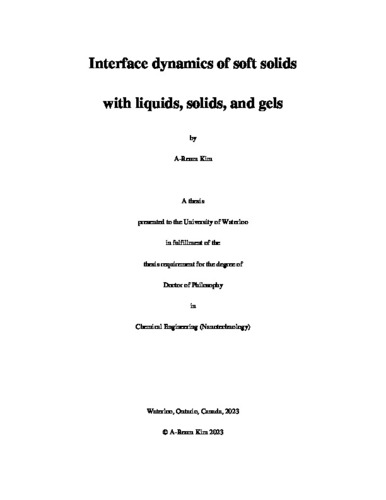| dc.description.abstract | Soft solids are commonly composed of polymeric networks suspended in liquids while maintaining their physical form. They have intermediate properties between viscous liquids and elastic solids, which are easily deformed even by small stresses (e.g., the interfacial tension with liquid droplets) but also resist deformation. Their distinctive softness has attracted many researchers and engineers to fruitfully apply soft solids in modern technologies such as 3D printing, in-vitro studies, soft robots, diagnostic chips, and artificial organs. In addition, many biological materials are soft solids, such as living tissues capable of conforming to the surface shape of the culture substrate and easily adapting to the surrounding environment.
The intermediate properties of soft solids create distinctive and unpredictable behaviors at interfaces beyond the scope of classical physics for pure liquids and solids. For example, soft solids show a time lag between the applied stress and the resultant strain. In addition, under certain extreme stress, soft solids might experience phase-separation between liquid and solid phases. Also, the polymeric chains might cause stick-slip motions of spreading liquid or sliding solid in contact with the soft polymeric surfaces. Understanding and controlling the different interfacial properties (e.g., lubrication, adhesion, and wetting) of soft solids are crucial to developing advanced technologies for using soft solids and better understanding the wisdom of nature. However, the physical principles behind numerous phenomena at soft interfaces are not yet clearly understood. Thus, the objective of this dissertation was to reveal the root causes of the salient features of different soft contact systems: soft solids in contact with sliding solids, flowing fluids, and stationary solids and gels.
The sliding tribosystem is one of the most prevalent contact systems. In this thesis, the role of viscoelasticity was first investigated on the sliding tribological behavior with and without lubricants. The lateral friction force of purely soft tribopairs (soft-on-soft) was examined. Through a regression analysis, a correlation was found among key parameters (e.g., sliding speed, preload, and viscoelasticity), showing the significant role of the loss tangent in the friction coefficient. On the one hand, above a certain level of free liquids in the elastic network of tribopairs (~ 30 wt.%), the liquid phase predominantly reduced the friction coefficient, potentially working as a lubricant at the interface.
Inspired by the findings on the role of the free liquids in the sliding tribosystem, a more detailed study on the surface deformation of soft solids with a larger fraction of liquids (~ 62 wt.%) (i.e., gel) was further investigated in contact with a stationary glass sphere. The soft surface evolved significantly longer (~ 85 hr) than its typical time scale (milliseconds) while the resultant strain was still within the elastic limit. The reasons behind this were the predominant finite-size and preload effects, minimized or neglected in most conventional and modified contact theories. The scope of research in this thesis was further expanded by engaging flowing Newtonian fluids (e.g., water and glycerol) in contact with soft solids.
The role of viscoelastic solids was researched on the flowing fluids by measuring the pressure drop of flowing fluids. To focus on the interface dynamics between soft solids and flowing fluids, the deflection of soft walls (i.e., bulging effect) was prevented by fabricating soft walls inside a rigid backing layer (i.e., rigid tube). Nonetheless, soft wall channels presented a reduced pressure drop compared to the calculated value of the Hagen-Poiseuille equation for rigid channels. As the free liquids fraction of the soft walls increased, the lower pressure drop was measured, implying that less energy was consumed. The cause of this reduced pressure drop was found to be the lubricating effect of free liquids on the soft surfaces, which was confirmed through dynamic contact angle measurements.
Lastly, via gels, the static contact signatures of two extreme physical states, pure liquids and solids, were bridged. A broad range of the effective elasticity of contact pairs was investigated from as low as near zero Pa to a few GPa. A scaling law was provided, connecting the wetting and adhesive contact regimes based on the measured contact radius and wetting foot. In addition, the experimental findings were validated through comparison with the experimental data presented in representative previous studies. | en |

